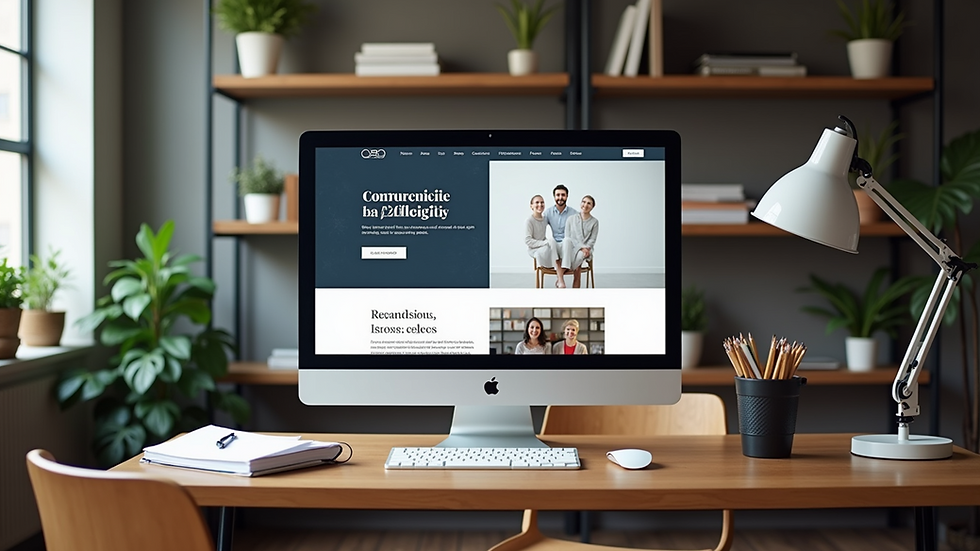Elevate Your Small Business with Better Web Design
- Donald W. Carroll
- Jul 31
- 4 min read
In today’s digital world, having a strong online presence is essential for any small business. Your website is often the first interaction potential customers have with your brand. A well-designed website can build trust, showcase your products or services, and ultimately drive sales. On the other hand, a poorly designed site can turn visitors away and hurt your business reputation. This article explores how small business web design can elevate your business, practical tips to improve your site, and why investing in quality design is a smart move.
Why Small Business Web Design Matters
Small business web design is more than just aesthetics. It’s about creating a seamless experience that guides visitors toward taking action, whether that’s making a purchase, booking a service, or contacting you for more information. Here are some key reasons why good web design is crucial:
First Impressions Count: Visitors form an opinion about your business within seconds. A clean, professional design signals credibility.
Improved User Experience: Easy navigation and fast loading times keep visitors engaged and reduce bounce rates.
Mobile Responsiveness: With more people browsing on phones and tablets, your site must look and work well on all devices.
SEO Benefits: Search engines favor websites that are well-structured and user-friendly, helping you rank higher in search results.
Brand Consistency: Your website should reflect your brand’s personality and values, creating a cohesive experience across all channels.
Investing in small business web design means investing in your business’s future growth and success.

Key Elements of Effective Small Business Web Design
To create a website that truly elevates your business, focus on these essential design elements:
1. Clear and Simple Navigation
Visitors should find what they need quickly. Use a straightforward menu structure with clear labels. Avoid clutter and too many options. Consider adding a search bar for larger sites.
2. Strong Visual Hierarchy
Use size, color, and placement to highlight important information like calls to action (CTAs), contact details, and product features. This guides visitors naturally through your site.
3. Fast Loading Speed
Slow websites frustrate users and increase bounce rates. Optimize images, use efficient coding, and choose reliable hosting to keep your site speedy.
4. Mobile-Friendly Design
Ensure your site adapts to different screen sizes. Test on various devices to confirm usability and appearance.
5. Engaging Content
Use concise, benefit-focused copy that speaks directly to your audience. Incorporate images, videos, and testimonials to build trust and interest.
6. Consistent Branding
Use your brand colors, fonts, and logo consistently. This reinforces your identity and makes your site memorable.
7. Clear Calls to Action
Tell visitors exactly what you want them to do next, whether it’s “Buy Now,” “Contact Us,” or “Subscribe.” Make CTAs prominent and easy to find.
By focusing on these elements, you can create a website that not only looks great but also drives results.

Is Web Design a Profitable Business?
Web design is a thriving industry with significant profit potential, especially when serving small businesses. Here’s why:
High Demand: Every business needs a website, and many small businesses seek affordable, professional design services.
Recurring Revenue Opportunities: Offering maintenance, updates, and SEO services can create ongoing income.
Scalability: Web designers can expand their services to include branding, digital marketing, and e-commerce solutions.
Low Overhead Costs: Many web designers work remotely with minimal expenses.
Creative Satisfaction: Helping businesses grow through design can be rewarding beyond financial gains.
For entrepreneurs considering entering the web design field, focusing on small businesses is a smart niche. Small businesses often require personalized service and are willing to invest in quality design to compete effectively.
Practical Tips to Improve Your Small Business Website Today
Improving your website doesn’t always require a full redesign. Here are actionable steps you can take right now:
Audit Your Current Site
Review your website from a visitor’s perspective. Identify confusing navigation, slow pages, or outdated content.
Optimize Images
Compress images to reduce load times without sacrificing quality.
Update Content
Refresh your copy to focus on customer benefits and include relevant keywords.
Add Clear CTAs
Make sure every page has a clear next step for visitors.
Test Mobile Usability
Use tools like Google’s Mobile-Friendly Test to identify issues.
Improve Contact Options
Include multiple ways for customers to reach you, such as phone, email, and chat.
Leverage Social Proof
Add testimonials, reviews, or case studies to build trust.
Secure Your Site
Use HTTPS to protect visitor data and improve SEO.
By implementing these tips, you can enhance your website’s effectiveness and start seeing better engagement and conversions.

How to Choose the Right Web Design Partner
If you decide to hire a professional, selecting the right web design partner is critical. Here’s what to look for:
Experience with Small Businesses
Choose a designer who understands the unique challenges and goals of small businesses.
Portfolio and References
Review past work and ask for client testimonials.
Clear Communication
Your designer should listen to your needs and explain their process clearly.
Focus on User Experience
Prioritize designers who emphasize usability and mobile responsiveness.
SEO Knowledge
A good designer will build your site with SEO best practices in mind.
Post-Launch Support
Ensure they offer ongoing maintenance and updates.
For those interested in exploring professional options, web design small businesses is a great resource to find experienced designers who specialize in helping small businesses grow online.
Taking Your Small Business to the Next Level
Investing in better small business web design is a powerful way to elevate your brand and increase your reach. Whether you choose to improve your current site or partner with a professional, focusing on user experience, clear messaging, and mobile optimization will pay off.
Remember, your website is often the first impression customers have of your business. Make it count by creating a site that is attractive, easy to use, and aligned with your business goals. With the right approach, your website can become your most valuable marketing asset.
Start today by assessing your current website and making small improvements. Over time, these changes will build a stronger online presence and help your business thrive in a competitive market.





Kommentare